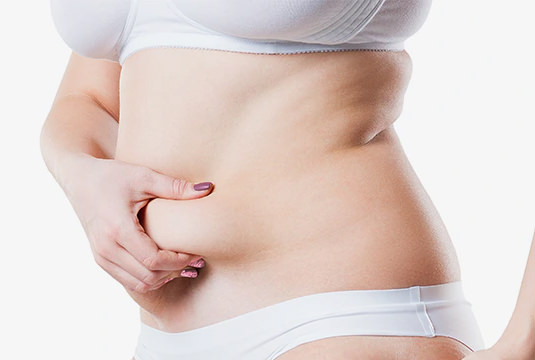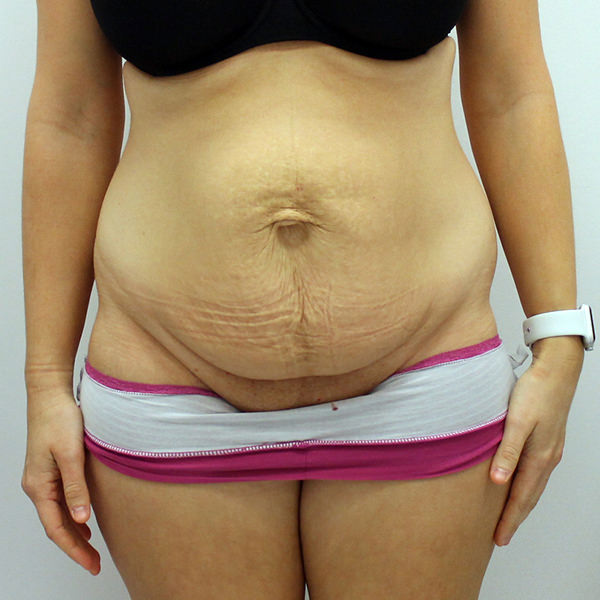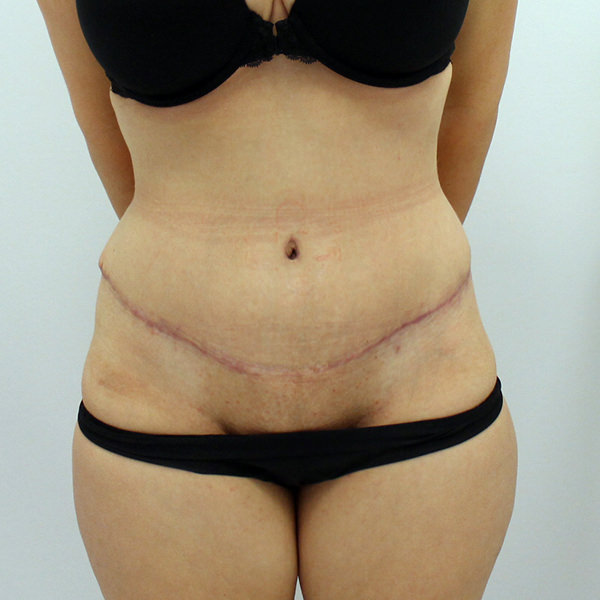The goal of a tummy tuck at Phi Plastic Surgery is to remove excess fat and skin from the abdomen as well as correct the diastasis recti – the space created between the abdominal muscles after pregnancy or weight loss. This procedure restores the abdominal contour and can be combined with liposuction of the upper abdomen, flanks, and pubis to improve the result.
Patients who are good candidates for this procedure
- Are at a stable and healthy weight
- Have no significant medical problems
- Non-smokers
- Not on blood thinners
- Have “pinchable” skin/fat below the belly button

Patients who are poor candidates for this procedure
- Obese (want or need to lose weight)
- Smoker
- Have serious medical problems
- Have intra-abdominal fat (non “pinchable” fat)
- On blood thinners
ARE YOU A CANDIDATE?
Our Self-Evaluation Quiz can help you decide if a tummy tuck is the right procedure for you.
Techniques for Abdominoplasty
The scar is from hip to hip along the crease between the lower abdomen and pubic area, as well as a scar around the belly button. Patients can go home on the same day as the surgery with drains (tubes that collect the swelling under the skin).
- Mini-abdominoplasty: This procedure generally combines liposuction of the abdomen with a horizontal suprapubic incision from the inner edge of the hip bone across to the other inner edge of the hip bone. This type of tummy tuck does not reposition the navel; therefore, there will be no scar around the belly button. This procedure is suitable for patients with a small amount of excess skin and fat in the lowest part of the abdomen.
- Abdominoplasty with lipo 360: A tummy tuck with lipo 360 generally includes both tummy tuck (abdominoplasty) and circumferential liposuction. Abdominoplasty will remove all the skin under the navel and reposition the navel. The scars have a horizontal component above the pubic area, rising laterally towards the hips and a periumbilical scar. Liposuction 360 includes liposuction of the abdomen, hips, flanks, and back.
- Fleur-de-lys or inverted T abdominoplasty: Similar to a traditional tummy tuck, this abdominoplasty uses a central vertical incision from the sternum to the pubic region to remove and tighten excess horizontal skin. This procedure is for patients with excess side-to-side skin after significant weight loss or bariatric surgery.



















Discover the procedure through live surgeries
Abdominoplasty presentation
Abdominoplasty procedure
Consent for Abdominoplasty
Pre op instructions for Abdominoplasty
At Phi Plastic Surgery, we believe that a beautiful body can take many shapes and sizes. The Phi philosophy centers on respecting your body's proportions and helping you let your inner beauty shine.
We offer our patients the best, most advanced techniques to help them achieve their aesthetic goals.
Pre-op & post-op instructions
These pre-surgical and post-surgical instructions are provided as essential services for you. Please follow the instructions carefully to ensure optimum results. If there are instructions that need to be clarified, please feel free to contact our office as soon as possible. If some instructions are not followed, your surgery could be delayed if deemed necessary by your surgeon.
PRE-OP INSTRUCTIONS
ONE MONTH before your surgery
- Stop using contraceptive pills or hormone therapy.
- A pre-operative visit (if necessary) approximately one month before your surgery will be scheduled to review your goals and provide you with additional information regarding your surgery.
THREE WEEKS before your surgery
- Stop all consumption of collagen
- Complete your preoperative tests. Be sure to complete all prescribed pre-operative tests (ECG blood tests, etc.). If all medical results and clearances of your tests are not received on time, your surgery may be delayed.
- Prepare your surgery date: Plan to ensure a stress-free experience. Arrange your work leave and special assistance to help you with ride home. Prepare your return by organizing meals, delivery, babysitting, etc. Make sure you have someone scheduled to accompany you home after your surgery. Someone should also be on-call to help you during the first 24 hours after your surgery.
TWO WEEKS before your surgery
- Stop the consumption of anti-inflammatory drugs.
- A preoperative visit (if necessary), approximately two weeks before your surgery, will be scheduled to review your goals and provide you with additional information regarding your surgery.
SEVEN DAYS before your surgery
- Stop taking any supplements or medications from the list below. These products can increase the risk of bleeding and other complications. Stop consuming any non-prescribed supplements including: Omega 3-6, nutricap, echinacea, glucosamine, fat burners, St. John’s wort. Aspirin, drugs containing aspirin or any anticoagulants such as arixtra pf, clopidogrel, plavix, coumadin, dalteparin, edoxaban, eliquis, apixaban, enoxaparin, fragmin pfsyringe, lepirudin, padaxa, dabigatran etexilate, xarelto, rivaroxaban.
- Confirm your surgical support plan: This includes your transportation and post-surgical care, including an adult family member or a friend on-call for your support, 24 hours after your surgery.
- Purchase any prescription provided by Dr. Gdalevitch (If applicable) and revise your pre-surgical instructions.
The day BEFORE your surgery
Prepare a bag. It should include:
- All necessary papers
- Your identification (RAMQ card)
- Prescription Drugs
- Glasses if necessary
- Confirm the person who will assist you for the first 24 hours after surgery.
- Take a shower. Use a non-perfumed soap. Wash your hair. Do not put cream or lotions. Do not put deodorants, hair products, perfumes, or makeup.
- Remove any nail varnish (even if transparent) from your hands and feet, including shellac, resin, gel or acrylic. All this reduces the risk of post-surgical infections and nails are monitored for blood circulation.
- Do not eat anything or drink any dark liquids for 8 hours before your surgery. Do not drink any light liquids 6 hours before your surgery. Anything you eat can cause cancellation of your surgery and increase the risks associated with surgery and anaesthesia. This includes sweets, mints, chewing gum, tea or coffee. You can take a very small amount of water after brushing your teeth or taking medication.
- Relax. Enjoy a good night’s sleep and avoid stress.
YOUR SURGERY DAY
- Do not drink or eat the day of your surgery
- Do not train before surgery
- Please bring your medications which have been prescribed to you in a bag as above.
- Please bring your compression socks if they have been prescribed to you.
- Do not wear any make-up, jewellery, contact lenses, hairpin or piercings: during surgery, an electric cautery is used, any piercing or jewellery can cause burns.
- Wear light and comfortable clothing. Wear a top that opens forward. Do not wear a sweater, turtleneck or tight clothing. You can wear a skirt, but pants and a jogging jacket are ideal. Flat shoes should be worn that are easy to put on and remove (no heels). A lip balm is recommended.
POST-OP INSTRUCTIONS
When you get home
You can expect to have some pain and feel that your abdomen is tight. To help you rest comfortably, follow these instructions:
- Take extra strength Tylenol every 4 hours
- Take an anti-nausea medication such a Gravol 30 minutes prior to taking your prescribed pain medication
- Take the pain medication as prescribed
- Take your antibiotics as prescribed
- Keep your garment on
- Stay in a semi sitting position (flexed) even when sleeping
- Empty your drains as was shown to you by the nurses
- Drink a lot of fluids
Please communicate with us immediately if you have:
- Fever over 38.5 Celsius
- Severe nausea or vomiting
- Hallucinations or unusual behavior
- Pain that is not controlled by medications
- Excessive bleeding or drainage from your incisions
- Pain or swelling of one calf
- Incapable of urinating
The day after surgery
- You can expect that your pain will start diminishing after 72 hours
- Swelling may increase over the first two days
Healing and follow up
- You will be swollen for 4-6 weeks
- You must continue to wear your garment during this time
- You won’t be able to straighten out for 5-7 days until your skin stretches
- It is recommended to rest for at least 1-2 weeks
- You will have a follow up appointment between 1 and 2 weeks
- The drains will be removed between 1 and 2 weeks
- You will not see the final result before 1 month. Scarring continues to improve for 6 months to a year.
Your results
Recovery from a tummy tuck generally consists of taking pain medications for 48 hours. It takes four weeks for the skin to heal and 4-6 weeks for the initial swelling to resolve.
A tummy tuck will help you obtain a flatter and firmer abdomen and will accomplish the following:
- Removal of excess lower abdominal skin and stretch marks
- Tightening of the abdominal wall
- A flatter abdomen and narrower waist
- Increase self-confidence that comes with an enhanced abdominal shape
The result is a more beautiful silhouette (hourglass), and a more sculpted abdomen.


View most frequently asked questions
What is a tummy tuck?
A tummy tuck is a surgery that removes excess skin and fat from the lower abdomen. This is combined with liposuction of the upper abdomen, flanks, and pubis to give a nicer result. The procedure also includes the correction of rectus diastasis, which is the separation of the abdominal muscles after pregnancy or weight loss.
Am I a good candidate for a tummy tuck?
The best candidates for this surgery are at a stable and healthy weight. You have to be sure to have finished having kids and be able to take the time to recover.
What are the techniques used in a tummy tuck?
A tummy tuck includes the excision of excess tissue under the belly button, plication of the abdominal muscles, transposition of the umbilicus and liposuction of the flanks, upper abdomen as well as pubic area. The incision stays low and goes from hip to hip with a small incision around the umbilicus.
How do I know if I have rectus diastasis?
You can examine the space between your abdominal muscles by lying down and raising your head. You can then feel the space between your abdominal muscles. Often after pregnancy, this space measures 1-5cm.
What happens to my cesarian section scar in an abdominoplasty?
The scar from the tummy tuck will likely be below the cesarian section scar so that it will be removed during surgery.
What should I expect after a tummy tuck operation?
You will be in a flexed position (at the hips) for 5-7 days while the skin stretches. The pain can be well controlled during the first days by taking your pain medication regularly. You will have a drain to empty during the first days. The average recovery takes three weeks (2-4 weeks).
What are the risks of a tummy tuck?
The procedure’s risks are rare but important and include the risks of general anesthesia, thrombophlebitis (blot clot in the leg), bleeding and infection. All possible complications and how to prevent them will be discussed during your consultation.
How much does the procedure cost?
Abdominoplasty
$14,000 - $16,000
Abdominoplasty with liposuction 360
$20,000 - $23,000
Abdominoplasty fleur-de-lys
starting at $17,000

For a more beautiful and proportional you!
φ Phi is the Greek symbol that indicates the golden ratio, a ratio that is synonymous with beauty.
Dr. Perry Gdalevitch offers a unique approach that involves applying the principles of perfect proportions (phi) to help you achieve your aesthetic and reconstructive goals.

 PLASTIC
PLASTIC